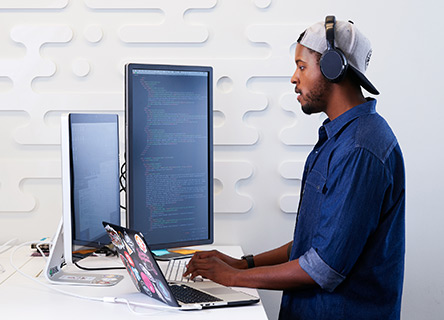Inclusion & Diversity
Why businesses need to take inclusion more seriously
December 18, 2019
Categorized: Inclusion & Diversity
Share this post:
Discrimination can happen to anyone: inclusion and diversity in the workplace is about so much more than race and gender.
Like heartbreak or the middle seat on a 17 hour Perth to London red-eye, there’s not much chance you’ll really understand how discrimination feels until it comes to call on you directly. However, the possibility of this is much more likely than most of us realise. Consider ageing; while getting older is generally the best possible scenario for you as a human, in Australia it’s one of the leading reasons you could be passed over for a new role or promotion.
Soft quotas and HR checkboxes don’t do a lot to change people’s attitudes and neither, it appears, does the massive amount of research that proves diversity hiring practices increase revenue, innovation and job satisfaction across all industries.
A fascinating global study by IBM called the Priority Paradox surveyed 2,300 organisations worldwide and found that most are relying on a ‘good intentions’ approach to diversity rather than making it a formal business priority. It also reveals that 79% of organisations globally say advancing women into leadership roles is not a formal business priority.
A 2018 study by Diversity Council Australia showed that only 22% of Aussie businesses actively measured the impact of diversity and inclusion initiatives. On the flip-side, the council’s Inclusion@Work Index also revealed that inclusive teams are 10 times more likely to be considered highly effective than workers in non-inclusive teams, 19 times more likely to be very satisfied with their jobs, and four times more likely to stay with their employer.
So, what’s the disconnect? IBM Inclusion and Diversity Partner for Australia and New Zealand, Keri Le Page asserts that “It’s not until people feel a personal emotional hook do they tend to act. The biggest barrier to inclusion is inertia closely followed by an inherent bias against those we perceive to be different from us.”
Unconscious bias, we’re all guilty
The truth is, no matter how aware we are, every human being is a victim to their own unconscious – or conscious – biases. Le Page explains, “it’s impossible to not have bias – it’s just the way our brains are wired. I have to constantly challenge myself to disrupt these biases. People understand at an intellectual level that diversity is good for innovation and therefore, good for business – but they don’t feel a burning desire for positive change. It’s the psychology of inertia – that people are busy and so are more likely to take the easy option and stick with the status quo than to actively work to change something.”
Also working against inclusivity is the fact that people in positions of privilege tend to underestimate the effect of bias. The Priority Paradox research uncovered that 65% of men believe that they would have been equally successful if they were a woman, and 15% believe that they would have been better off as a woman due to the gender equality movement.
This, Keri says, is despite the unmistakable reality that women are significantly under-represented in senior leadership roles, “It’s an egocentric bias; that my inherent qualities have created my success and therefore everyone else could succeed too if they tried hard enough.”
“People are blind to the structural biases that exclude the ‘out’ group from being judged on their merits – but instead stereotypes them as not the ‘right fit’ or not as good. Discussions of gender and race just scratch the surface – you also need to look at age, dis/ability, gender identity, sexual orientation, religion etc. – and then the intersection of these factors, e.g. sexual orientation combined with age, to truly appreciate the sometimes insurmountable barriers that many people face.
All of this means that the people in positions of power and privilege are less likely to truly prioritise diversity equality, less likely to feel genuine empathy with those in diverse groups and less likely to feel a burning desire to create change.”
But the value of overcoming these reflexes vastly outweighs the displeasure of leaving your comfort zone to do so.
Says Le Page, “Think about jury selection; when everyone on the jury panel looks the same and is from similar backgrounds, they’re far less likely to get to the heart of the issue, less likely to discuss and consider the case from all angles.”
But it’s those diverse perspectives and experiences are the only way a person on trial will be judged fairly. “Surely, that kind of diversified thinking is also valuable in the workplace?”
Where to begin
As a company, IBM has a long history of diversity and inclusion dating back over a century. Well ahead of its time, IBM hired women into professional roles before they were given the right to vote, and in 1914 hired its first employee with a disability, again into a professional role – 76 years before the Americans with Disabilities Act. This is exactly why Le Page was drawn to working with them, ‘I love never having to discuss why we need to put inclusivity nudges into changing our environment at IBM but just exploring how we do it.”
But for other companies and individuals starting the journey into diversity Keri says the work begins with, “Building personal relationships with a diverse group of people, to breaking down the them vs us reflex.”
“Selection panels for recruitment need to be more diverse, shortlists of candidates need to be more diverse. And that doesn’t mean a panel of five men and one woman, or five white people and one person from another culture. You need to set a standard that to be considered diverse both the panel and the short-list should include at least two people who are diverse from the others.”
She speaks to some companies testing the waters of inclusivity by removing gender from resumes at the selection processes, and others using the tools like the app Textio to check the gender bias in the wording of their job descriptions and recruitment ads.
Keri says it’s important to remember that, “gender inclusivity doesn’t just mean hiring more women – it means evening out the genders of all roles. Sometimes that’s going to mean hiring more men. The aim is for a split of 40% women, 40% men and the remaining 20% of either.”
It’s also about making the workplace expectations gender-neutral, “When my husband took three months paternity leave to care for our daughter 16 years ago, he was told by a very senior leader that his career was over. Luckily, they were wrong – but until we can create an environment where both men and women feel equally empowered to follow a path of their own choosing, then we will continue to struggle to see real inclusion.”
In the same vein, “Flex days should be available for everyone, not just for people to parent – if someone wants to be an artist on Fridays, and negotiates to work a four day week, then they should be able to do that.”
It sounds dreamy, but Keri believes it’s where the workplace is heading, “Most people genuinely want to make a difference once they understand the structural barriers that exist. However, it won’t just happen organically – it needs to be an active program of change. Cultural and normative changes happen slowly and can be invisible in the present time – however, eventually you look back and realise just how much the business has shifted forwards almost without realising it. That is the satisfying part!”
Originally published by News Corp on news.com.au.
How IBM is helping to skill South Australian students for the jobs of the future
By Jade Moffat Herman, Corporate Social Responsibility Lead, IBM A/NZ After almost seven years at IBM Australia and New Zealand, you don’t need to tell me how rewarding a career in technology can be. In my role as Corporate Social Responsibility Lead, I am honoured to work closely with leading public sector, not-for-profit and educational […]
Four Australian teams lead the 2021 Call for Code to help combat climate change
By Alison Haire, Lead Developer Advocate, Hybrid Cloud Build Team Solving global challenges like climate change may seem never-ending, but we can draw inspiration and hope from communities that are making a difference. The open-source movement is one such community, involving hundreds of thousands of individuals and organisations around the world. Together, they have created […]
How to avoid data breaches while accelerating your digital transformation
Author: Chris Hockings, Chief Technology Officer (Cyber Security), IBM Australia and New Zealand As the pandemic accelerated your need for digital transformation, you needed to act. And fast. And you were not alone. But new findings from the recent IBM-Ponemon Institute Cost of a Data Breach Report 2021 suggest that an organisation’s pace of change […]


